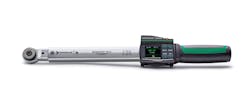Technological Transformation: A Torque Device for the Fourth Phase of the Industrial Revolution
The Manoskop 766 Daptiq is a computer-controlled electromechanical tightening torque wrench developed to ensure all bolts and connections are tightened with their specific tightening value. Stahlwille developed the product with a key customer and released it to the general public in 2019. When designing the product, Stahlwille kept Industry 4.0 standards in mind.
Industry 4.0 refers to the fourth phase in the Industrial Revolution that concentrates on interconnectivity, automation, machine learning and real-time data. It builds on the Third Industrial Revolution that started implementing computers into manufacturing processes.
Industry 4.0 relies heavily on the Internet of Things and Internet of Systems to make more accurate and uniform products. Many companies also use cloud computing and analytics, AI and machine learning throughout their operations. Now — and into the future as Industry 4.0 expands — computers are able to communicate and make decisions with little to no human intervention. The Manoskop 766 Daptiq is just one of the many products that have come out of this technological transformation.
“The 766 is a computer-controlled torque device that allows a production line — via a manufacturing execution system — to set a specific tightening value and/or angle to the 766 without the influence of a human,” said Marcel Mertens, business development manager for Stahlwille. “It also sends the applied torque value immediately after the operation back to the manufacturing execution system to do a quality check.”
An end-user calibrates the Manoskop 766 Daptiq to the correct torque or angle used to tighten a bolt. The user then employs augmented reality (AR) goggles to see how much torque he is using to tighten the bolt in real-time. When the user exerts enough torque, the Manoskop 766 Daptiq clicks to let him know the bolt is tightened correctly.
Mertens said there are similar products on the market but none has a mechanical click to alert the end user when he has exerted enough force. “There are competitors, but what our key benefit is, it feels like a normal good old manual torque wrench to the mechanics that use it,” he noted. “We are the only one in the world to build digital torque wenches with a mechanical click.” He noted Stahlwille has a patent on the technology.
Any industry that relies on accurate tightenings can use the Manoskop 766 Daptiq. In aerospace applications, it is typically used for tasks such as tightening aircraft wheel rims, bolts in engines or fuel hoses. Mertens noted each customer is different and Stahlwille is able to set up the Manoskop 766 Daptiq based on its unique needs.
Key Features
The Manoskop 766 Daptiq has some unique abilities that make it perfect for highly-flexible, semi-automated work environments.
The tool has a bidirectional interface, which means it can receive instructions and respond wirelessly to signals from the network. Getting rid of cable connections makes it easier to apply settings from the production control system quickly and efficiently. The tool uses the ISM band (868 MHz) for wireless communication. This is an exclusive frequency range for industry, science and medical applications. It can also use the 915 MHz frequency band in the United States.
It also transmits signals at extremely short intervals. This way, the production control system gets adequate data to precisely track the tightening action in real time. The tool is extremely exact thanks to the low display deviation value — plus/minus two percent for torque and plus/minus one percent for angle.
Stahlwille thought ahead when developing the product and made all the control commands for the tools openly accessible. All system integrators at the customer’s site can use the commands they need to link the tool into their production workflows however they see fit.
“If you, for example, go to a manufacturer with highly automated production, robots and everything are controlled via a complex software,” Mertens said. “We are able to adapt the 766 to the software system wherever it’s needed. If there is a manual step or even a reworking line, the 766 allows the manufacturer to track all tightenings done there, too.”
The Manoskop 766 Daptiq even has the ability to read fastener tightening data automatically for logging purposes. The tool can archive those details in the company’s subsystems. This allows for faster, more efficient processes and can verify how the fasteners have been manipulated. The receiver station is able to process data from several Manoskop 766 Daptiqs at the same time.
Another feature the tool has is the ability to configure itself for the next fastener. The tool can instruct the end-user how to tighten a specific piece of equipment.
“The mechanics using the 766 do not have to change the setting by themselves,” Mertens explained. “This is done by a computer system. If there is a sequence of let’s say 10 bolts — two with 10 in./lb., two with 25 in./lb. and six with 30 in./lb. — and they are tightened one after the other, the mechanic only has to do the operation and not to set each value. This is done automatically.”
Eyes on the Future
The tool is also virtually wear-free, meaning it has a long service time. Mertens attributes this to Stahlwille’s long and impressive track record in the tool manufacturing business.
“We are an old German tool manufacturer that has been around since 1862,” he said. “In the beginning, that was processing steel to a perfect hand tool and also manual torque wrenches with outstanding made-in-Germany quality.”
He noted, since the beginning of Industry 4.0, there has been more emphasis put on checking every bolt and connection before a plane is returned to service. Stahwille developed the product, “to allow our customers to increase their product quality in terms of ‘all bolts and connections are tightened with their specific tightening value’ and allow them to have a digital twin of all products processed within the 766,” Mertens said. “We think this is the way forward.”
